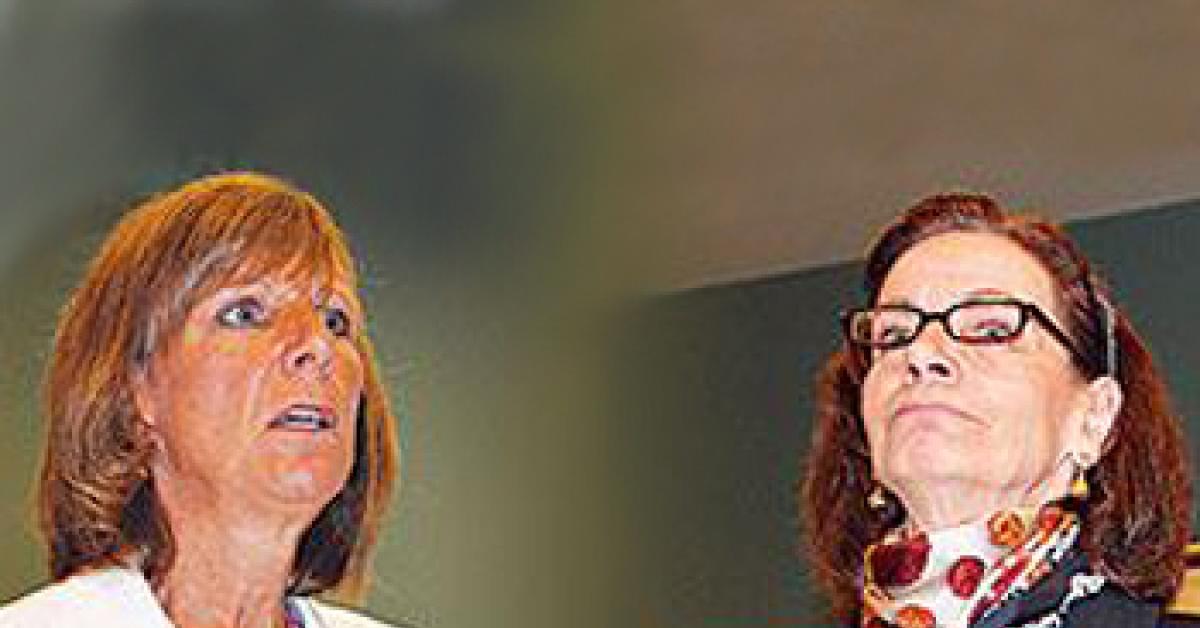LONG BEACH, Calif. — Mary Scalco, CEO of the Drycleaning & Laundry Institute (DLI), and Nora Nealis, executive director of the National Cleaners Association (NCA), visit a lot of dry cleaning operations in their work. They are direct competitors, but they share a common goal: improving the dry cleaning industry and helping its operators learn how to build better businesses.
And so the two recently collaborated on an educational seminar, offered during the California Cleaners Association’s Fabricare show, that demonstrates What Cleaners Are Doing to Thrive Today.
SEE THINGS DIFFERENTLY
If you want your dry cleaning business to thrive, Scalco says, there’s something you must do. “You change the way you look at things, and the things you look at change.”
You’re no doubt familiar with the FedEx logo, as it can be seen on the delivery company’s trucks, on billboards, in TV commercials, and more. But did you ever notice that the logo contains within it an arrow? It is an ingenious way to depict movement, she says.
“When you walk into your store, you have to see it not as you see it every day but you have to see it through your customers’ eyes,” Scalco says.
She displayed a photo of an unidentified plant’s cluttered entrance, a customer just about to walk through the door. “If you were a consumer carrying your clothes, would you want to walk through that to get to the front counter?”
A photo taken at another plant depicted what anyone could see while standing at the front counter: a dry cleaning machine surrounded by spotting chemicals, half-empty detergent bottles and more. “If I’m dropping off at the counter and that’s what I see, do you think I want to leave my bright white suit in that plant?”
Greater plant efficiency can be achieved by using more automation, and that’s not going to change, Scalco says. But sometimes gaining efficiency just comes down to using common sense.
Workers at an unidentified plant routinely ran only 10-pound loads in their two 50-pound dry cleaning machines, but why? Three stain removal technicians worked there. “When (one) was done with his load, pre-spotting, that went in the machine, and that ran,” Scalco explains. “Then, when this person was done with theirs, what they were working on went in the machine. It made absolutely no sense.”
Schedule your best counter service representatives in the afternoon, Scalco advises. Customers dropping off clothes on their way to work in the morning are often in a rush, while those coming in to pick up garments in the afternoon are more relaxed and conversational, she says.
MEET CUSTOMERS WHERE THEY ARE
Just like your operation is not the same these days, your marketing should not be the same, according to Scalco. She shared some statistics that illustrate the growing popularity of social media such as Facebook and Twitter: One in every eight people use Facebook (50% log in every day), and 58% communicate with others more often online than in person.
“This is how they’re getting their information,” Scalco says of your customers and prospects. “You have to make sure you are communicating. It’s a new realm. You might not be able to do it, but I dare say that you can find someone of a younger age who knows how to do it and set it up.”
Use social media to familiarize the community and its residents with your business. Massachusetts-based Dependable Cleaners promotes a summer reading program in which children have the chance to win a bike. California’s Milt & Edie’s regularly stages contests via social media and gives the winners $50 service vouchers. And there are many other examples.
If you’re wondering if such efforts pay off, follow the example of Virginia’s Puritan Cleaners. The company sponsors “Free Pants Wednesday.” Every year, on a Wednesday in August, anyone in Richmond, Va., can bring in a pair of pants and have them cleaned for free. The first year, in 2009, the business cleaned 1,311 pants on Free Pants Wednesday, but total piece count was up 47.3% and total revenue jumped 26.7%. The next year? There were 1,546 free pants (303 return customers), while total pieces were up 74.3%, total revenue rose 33.5%, and the cleaner gained 644 new accounts. The third-year outcome: 1,764 free pants, total pieces up 103.6%, total revenue up 57.3%, and 252 new accounts.
Steininger’s in Pennsylvania has what it calls nine “convenience” locations in other area businesses (40- to 50-mile radius) such as tailors, card stores and even a monument company. Steininger’s provides a rack, bags, hangers, etc., and gives the businesses 20% of sales over $1,000 a month.
MAKING MORE MONEY
There are only a handful of ways, Nealis says, to make more money: increase the number of new customers, increase customer spending per transaction, increase frequency of customer use, or increase customer retention. Or you can try controlling costs to “save” yourself into profit.
“You’ve got to be sure you cut the fat and not the muscle,” she says. “And cutting soap is not a great way to cut costs. Your customers want clean clothes. Soap helps.”
Nealis focused on ways to increase sales and gain new customers, using real-world examples.
Noble Cleaners took a closer look at his store’s “curb appeal” when sales dipped (before the advent of CitySearch and Yelp, 60% of new customers came in because they saw the business, she says). Over time, features such as the awning and planters had become outdated.
“What are the best marketing dollars you can spend? Windex, elbow grease, vacuum. We’re cleaners. What does that mean?”
Help your customers associate you with quality clothing designers. Here’s a low-cost decorating idea for your call office: frame and display designer shopping bags, adding your own to the mix.
In New York City, an unidentified high-end cleaner upgraded its drop store’s appearance, but went so far that passersby didn’t recognize it as a dry cleaning business. What could it do with two little window displays? It purchased and displayed Barbie dolls adorned in designer clothing, then posted a sign reading, “Barbie trusts us with her Burberry, you can, too.”
Children leave fingerprints on the windows, but they also bring their mothers back to “see the windows” on the weekend, and new accounts are born. “It just takes a little creativity, a little thinking outside the box,” Nealis says.
Cleaners are also taking advantage of a fairly new program offered by the U.S. Post Office called Every Door Direct Mail. The cost to mail a piece as large as 9-by-12 is minimal, and no mailing list is required, Nealis says.
“You can select a ZIP code, or a mail carrier route, and you can mail your story to them—minimum 200 pieces—for 14.5 cents. This, my friends, is a gift from the gods.”
Nealis says the cleaners she’s spoken to have seen customer response ranging from 2%, which is fairly average, to as much as 31%.
When making deliveries, Cricket Cleaners leaves hang tags on neighbors’ doors to spread the word about its service.
While much has been said about social media, don’t abandon print advertising, Nealis says. “According to researchers, you make a more emotional, permanent connection with people if they see something in print … you don’t want to turn your back on print. Print has a value.”
Dry cleaners are working harder to educate their customers about what they do. Bridge Cleaners uses two monitors above the front counter to display information about its service portfolio.
Some NCA member cleaners report success in introducing a new level of service (couture) with a new anchor price. They may have gotten the idea from the hotel industry, which offers varying levels of amenities at different price points.
Nealis referred a friend, Stacy, to Boston’s Holly Cleaners, which charges 50% more for its HollyCraft couture service than its base price. Stacy was thrilled with the service, describing it as “detailing my clothes.” She started by taking only cashmere sweaters, but was soon taking her other more expensive items there because “those clothes are worth it.”
And if customers don’t use your couture service, it makes your basic service look more affordable and thus attractive, Nealis says.
Winzer Cleaners promotes cleaning services tied to moving, a frequent occurrence in the New York City area. When Apthorp Cleaners lost its lease and had yet to find a new location, it offered in-home tailoring. Paragon Cleaners introduced a maid service.
Nealis wrapped the presentation by suggesting that cleaners “shop the big ticket items” affecting their bottom line: business and auto insurance, health insurance, credit card processing (one cleaner saved $162 a month by demanding its current provider match a competitor), and mortgage rates.
And if you’re still using oil in your plant, make the switch to natural gas, Nealis advises. One cleaner saved at least $2,000 a month doing so.
It all adds up when you’re trying to not only survive but thrive.
Have a question or comment? E-mail our editor Dave Davis at [email protected].

